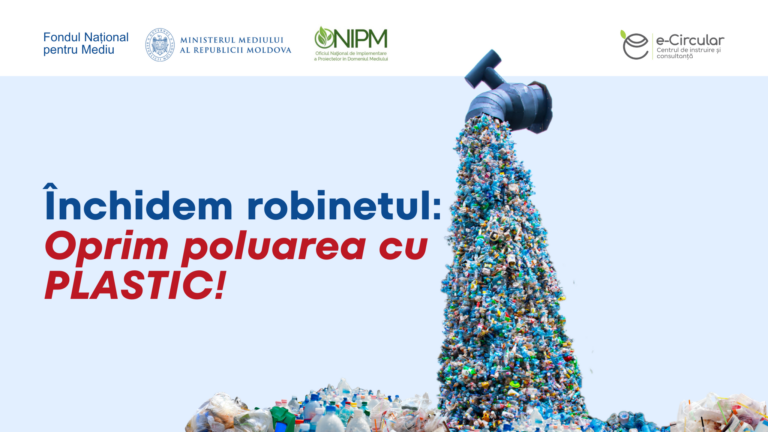10 recommendations to reduce the amount of WEEE
Details
Technology has evolved so rapidly in recent decades that today it is hard to imagine what our lives would be like without smartphones, laptops, washing machines, refrigerators and many other electrical and electronic devices.
But our addiction to technology and need for new devices has created one of the biggest environmental problems of our time – waste electrical and electronic equipment (e-Waste).
Annually, around 50 million tons of e-Waste are generated globally, and the amount of e-Waste generated in the Republic of Moldova is 8000 tons or approximately 2.2 kg per inhabitant.
The environmental impact caused by the improper disposal of e-Waste is:
- The air pollution - for example. burning cables releases hydrocarbons into the atmosphere.
- Water polution – electronic devices contain toxic metals such as mercury, lead and lithium, which when disposed of improperly end up in ponds and groundwater. Communities that depend directly on these water sources are unknowingly consuming hazardous water. These heavy metals are dangerous to all forms of living beings.
- Soil pollution – heavy metals from WEEE enter the food chain as they are absorbed by plants in the soil. These metals not only destroy plants, but are then consumed by other living things, leading to a poisonous food chain.
The amount of waste generated raises serious questions about how to reduction of waste electrical and electronic equipment. Minimizing e-waste helps conserve resources and reduces energy consumption.
Next, we present you 10 recommendations covering different stages of the product life cycle (purchase, use, transformation into waste) through which we can reduce the amount of waste through direct and indirect actions of reduction, reuse and recycling.
1. We assess the need at the purchase stage
- Don't buy if you don't need it. It would be fair to inform ourselves and ask ourselves if we really need a new device (gadget) or if we simply "want" this device - and we were enticed with a story beautifully presented through an advertising spot. This recommendation is first and foremost – “the zero moment”, because if the product is not purchased, no waste will be generated. It may not be appropriate at the moment to purchase that device - and postpone the purchase for later - for example, in the case of a TV - which in a year will be cheaper, have more functions, a larger diagonal and will consume less energy electric, we only have to win.
- It may be better to get a device with more functions. For example – a food processor or multifunction printer, etc.
- Keeping information online. Why use a memory stick or device when we can easily store data on the Internet (in the Cloud). This indirectly reduces YOUR footprint. of carbon and reduces the amount of e-waste generated. There are currently many such free services – such as Dropbox, OneDrive and GoogleDrive.
According to the study conducted by Association for Waste Recovery within the project implemented with support The GEF SGP Moldova small grants program, 30% of home consumers decide to purchase a new device, due to the more advanced functionalities of the device.

2. We buy environmentally friendly electronic equipment
We look for products labeled as energy efficient – for example class A. In the long term this allows savings on electricity costs on the bill.
3. We extend the life of the device
- We keep the device in working condition as much as possible. We buy protective case and glass for the phone, keep the device clean and avoid overcharging the battery (this means disconnect the charger before the phone/laptop reaches 100%, which will improve the overall battery life).
- We optimize the operation of the device at the software level. We close unused programs running "in the background", install the latest software. We optimize the operation of the device according to our needs.
- We upgrade – if we need an upgrade, we consider replacing individual components instead of the whole equipment. Repair experts can help us identify the new components we need.
- We repair the device. Usually when a piece of equipment breaks down, only one part is broken, and in the vast majority of cases the device can be repaired. More and more often, the repair will cost us much less than purchasing a new device.
- We change the destination for further use of the device. In this case, we can use a secondary function of the device. For example – an old mobile phone can only be used as a car GPS navigator or garage security camera.
According to the study conducted by AVD, the majority of respondents noted that they change their mobile phone most often – 37% changes the phone once every 2 years at most, and 53% changes it once every 5 years at most.
4. We share, rent or exchange destinations
Each of these options avoids turning a product into waste. Therefore, you can share certain devices with family members, such as phone chargers, or share a drill with your neighbor, etc. At the same time you could try dual utility leasing. We thus manage to exclude storage due to the non-use of the electronic device, but also earn money from the rent.
5. Refurbish
Refurbishment refers to bringing the device back to normal (usable) condition. We purchase refurbished products or can through such programs pass on old equipment to electronics stores. Such programs are implemented by some of our stores such as Smart, Darwin, etc.
6. donate
By donating, we manage to give the equipment a second life, and someone will be happy that they got what they wanted. We can donate to charities, orphanages, needy people, various electrical and electronic equipment, of course in working condition.
According to the study carried out by AVD, people usually keep unused or already waste equipment, and 2 out of 10 donate it.
7. sell
Instead of trashing or storing – an alternative method would be to sell the device. Now during the pandemic - the easiest would be to sell online (www.999.md, www.makler.md) and the use of post terminals from the Post of Moldova (www.pt.md) so you won't need to interact with the buyer.
8. We educate and inform.
Learning about WEEE can motivate us to take action to reduce waste, and we can therefore inform others – family, friends and colleagues – about the environmental dangers of e-Waste. A first step would be to dispose of the batteries in the special battery bin.
9. We learn to repair broken electronic equipment.

In addition to maintaining electronic devices, we can also learn how to repair them. There are many videos on Youtube that teach us how to change a phone screen or battery, remote control cleaning, electronic toy repair, etc. Often, all it takes is a little time and patience before the device is as good as new – on its own. And learning to repair equipment at home, we will get more detailed knowledge about the hardware part of the device. Online sites such as iFixit offers free step-by-step guides to solving common problems on hundreds of different device models, along with images of the device and the tools needed for each type of repair.
10. We dispose eco-responsibly
We dispose of electronics and batteries in specially designed recycling bins. For example – on Map of e-waste collection points you can find the nearest location to properly dispose of small, medium and large e-Waste such as: mobile phones, batteries, electronic watches, monitors, tablets, electronic toys, vacuum cleaners, TV, etc.
Inside the project "Clean city with recycled e-Waste" implemented by AVD with the support of the Small Grants Program GEF SGP Moldova in partnership with MoldRec, a total of 128 e-Waste collection points were created, 8 of which are large dumpsters located on the territory of BEMOL filling stations.
Careful! And finally, we want to remind you that no matter what you do with the electronic device - donate or sell - remember to delete the personal information from the device.
| Date next time you see someone inappropriately throwing away an old TV or buying a new smartphone for no reason, take a moment, reflect and share your knowledge about the harmful effect of the actions. Most importantly, give these people a reason to act on your advice. For example, if you know of a good place nearby to donate old electronics, be sure to let them know! An honest discussion about responsible ways to reduce e-waste make a measurable difference both in the community and on a global scale. |









